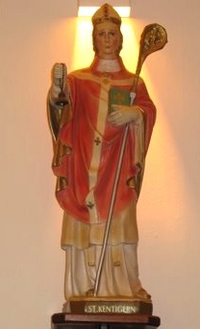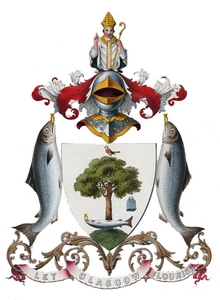 Our patron Saint Kentigern was the first Bishop of Glasgow where he is known as Saint Mungo meaning “the beloved one”. “Kentigern” derives from the Welsh Cyndeyrn, meaning “Chief Prince”. He was born in North Britain about 518 in the kingdom of the Picts. After being consecrated by an Irish Bishop, he sent many missionary monks to the north of Scotland, in the Isles of Orkney, then in the Kingdom of Norway and to Iceland.
Our patron Saint Kentigern was the first Bishop of Glasgow where he is known as Saint Mungo meaning “the beloved one”. “Kentigern” derives from the Welsh Cyndeyrn, meaning “Chief Prince”. He was born in North Britain about 518 in the kingdom of the Picts. After being consecrated by an Irish Bishop, he sent many missionary monks to the north of Scotland, in the Isles of Orkney, then in the Kingdom of Norway and to Iceland.
He was driven from his See by the Pelagian heretics and took refuge in Wales where he stayed with Saint David and was present when David died in 544. He returned to what we now call Glasgow in about 560 since we know that he met Saint Columba who came over from Ireland to lead a missionary effort in the same area where Kentigern was working.
St. Kentigern is often pictured carrying a bell, which is thought to have been given to him by the Pope. It was said to have been used in services and to mourn the deceased. The original bell no longer exists, and a replacement, created in the 1640s, is now on display in Glasgow.
 St. Kentigern appears in the crest of Glasgow’s coat-of-arms along with his miracles. A series of verses are used to remember the four miracles:
St. Kentigern appears in the crest of Glasgow’s coat-of-arms along with his miracles. A series of verses are used to remember the four miracles:
Here is the bird that never flew
Here is the tree that never grew
Here is the bell that never rang
Here is the fish that never swam
The Bird – Kentigern restored life to the pet robin of Saint Serf, which had been killed by some of his fellow classmates, hoping to blame him for its death.
The Tree – Kentigern had been left in charge of a fire in Saint Serf’s monastery. He fell asleep and the fire went out. Taking branches from a tree, he restarted the fire.
The Bell – As mentioned previously.
The Fish – refers to the story about Queen Languoreth of Strathclyde who was suspected of infidelity by her husband. King Riderch demanded to see her ring, which he claimed she had given to her lover. In reality the King had thrown it into the River Clyde. Faced with execution she appealed for help to Kentigern, who ordered a messenger to catch a fish in the river. On opening the fish, the ring was miraculously found inside, which allowed the Queen to clear her name.
St. Kentigern died c.603-612 and a Cathedral in Glasgow was built in his honour. His feast day is the 13th of January.
Saint Kentigern: A companion on our journey of faith
Whenever planning a journey there are some essential tools we need from maps to sat nav’s and road signs. It is these tools that help us reach the destination we set off for. Our journey of faith towards Jesus is no exception. We need guidance and direction to help us on our way and we are blessed that God has given us saints like Kentigern who act like divine signposts steering us on the right road towards Christ. As the letter to the Hebrews reminds us: “Remember your leaders, who preached the word of God to you, and as you reflect on the outcome of their lives imitate their faith.” (Heb.13:7)
A monk called Jocelyn living just over 800 years ago at Furness Abbey in Cumbria did exactly that, he reflected on the life of St. Kentigern and wrote down an account of this holy bishop so that others could imitate him and be inspired by him. The words of this Cumbrian monk’s history of Kentigern still guide and steer us toward knowing Christ better.
To prove those words true, that the saints are like heavenly signposts helping us come closer to the Lord, there is a wonderful episode in Kentigern’s life about the bird, the robin. Jocelyn recalls that as a young boy many of Kentigern’s fellow pupils in the school of St. Servanus at Culross in Scotland were jealous of him. They were jealous for Servanus, their teacher, looked more favourably on Kentigern than the rest of them because he excelled in his studies and had a real desire to know Jesus. This jealousy came to a head one day when the bitter students took St. Servanus’ pet robin and severed its head from it body hoping to blame Kentigern for the evil deed. Jocelyn takes up the story from when the young saint came across the atrocity:
“…Putting the head upon the body, he signed it with the sign of the cross, and lifting up holy hands in prayer to the Lord, he said, ‘Lord Jesus Christ, in Whose hands is the breath of every rational and irrational creature, give back to this bird the breath of life, that Thy blessed name be glorified for ever.’ …Straightaway the bird revived.”
This story may seem very far-fetched by the standard of our modern minds yet if we look at it closely as a story that is meant to reveal religious truth rather than scientific truth then all becomes clear. In that moment of disaster the first thing that St. Kentigern did when he saw the lifeless body of the robin was to turn to God immediately in prayer. He imitated Jesus exactly. When Our Lord was worried before his arrest in the garden of Gethsemane he turned to God the Father in prayer (Lk 22:41-44), when he was on the cross he turned again to God in prayer (Lk 23:34) and when he was asked by a disciple how to pray he taught them to turn immediately to God by teaching: “So you should pray like this: Our Father in heaven, may your name be held holy…” (Mt 6:9)
As the Father heard the Son’s prayers so He heard Kentigern’s prayer because it was a prayer straight from the heart and born out of love like Christ’s prayers for us. It was a prayer said to take away the pain of another, to not let Servanus become distraught at the death of his pet.
What reveals Kentigern’s faith in Jesus most powerfully is when he made the sign of the cross over the murdered creature. The cross is truly one of the most powerful signs we possess because it reminds us that sin and death no longer have power over us. Why? Because Jesus Christ, God in flesh and blood, by his life death and resurrection has destroyed that abyss between God and man and restored all creation to its right and proper dignity. Kentigern knew that there was nothing more powerful than the cross and would have known those powerful words of St Paul:
“…Here we are preaching a crucified Christ; to the Jews an obstacle that they cannot get over, to the pagans madness, but to those who have been called, whether they are Jews or Greeks, a Christ who is the power and the wisdom of God.” (1 Cor 1:23-24)
As we begin this New Year let us make that resolution to walk towards Christ and know him better because he truly is the source of all joy and peace. We are not alone in this endeavour for God has blessed us with a guide, Kentigern our parish patron, who has shown us already the importance of prayer and the power of the cross. With prayer and the knowledge of the salvation that the cross brings are feet are already on firm ground and set on the right path.
Father Sean O’Brien
If you would like to see more information on the historical background to Saint Kentigern you can visit the sites below where you will find a comprehensive history of the Saint.
With thanks to Cynthia Green, Houston, Texas, who has kindly allowed me to link the parish web site to hers.
The Life of Kentigern by Jocelyn, a monk of Furness
Saint Kentigern, Apostle to Strathclyde: A critical analysis of a northern saint